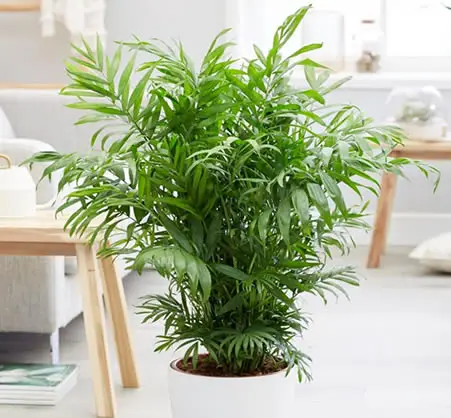The Parlour Palm (Chamaedorea elegans) is a graceful, low-maintenance houseplant that’s been a favorite since the Victorian era. With its soft, arching fronds and slow, upright growth, it adds a refined tropical touch without taking over the room. It’s especially popular for its ability to thrive in lower light and drier indoor conditions, making it perfect for modern homes and offices.
Here’s how to care for this timeless beauty indoors and out, and how to keep those feathery fronds healthy and lush.
Table of Contents
- Lighting for Soft Growth: Why Indirect Light Works Best
- Watering Routine for Happy Roots: Keeping Soil Lightly Moist
- Warm and Humid Conditions: What the Parlour Palm Prefers Indoors
- Fertilizing for Steady Growth: When and How Much to Feed
- Repotting Slowly: How Often to Refresh Its Home
- Best Place in the House: Where to Show Off a Parlour Palm
- Caring for Parlour Palms Outdoors: A Seasonal Option in Mild Climates
- Common Parlour Palm Problems and How to Fix Them
- Final Thoughts
Lighting for Soft Growth: Why Indirect Light Works Best
Parlour Palms grow best in low to medium indirect light.

They’re incredibly shade-tolerant and happy in rooms that don’t get direct sunlight.
Harsh rays can easily scorch the fronds, so avoid placing it in strong afternoon light.
It’s ideal for spaces that get gentle morning light or filtered brightness throughout the day.
Watering Routine for Happy Roots: Keeping Soil Lightly Moist
These palms like their soil to stay lightly moist but never soggy.
Water when the top inch feels dry, and let any excess drain out completely.
In cooler seasons, you can water a bit less.
Always make sure the pot has drainage holes to prevent root rot, which is the most common issue with this plant.
Warm and Humid Conditions: What the Parlour Palm Prefers Indoors
Keep your palm in a room that stays between 65°F and 80°F.

It doesn’t like cold air or drafts and may suffer if placed near air conditioners or drafty windows.
While it tolerates average indoor humidity, it will look its best with a little extra moisture in the air.
Occasional misting or a pebble tray can help in dry homes or during winter.
Fertilizing for Steady Growth: When and How Much to Feed
Parlour Palms don’t need much food to grow well.
A diluted liquid fertilizer once every 6 to 8 weeks during spring and summer is plenty.
Use a good quality 10-10-10 fertilizer, such as this one, or a 20-20-20 fertilizer, like this one.
Skip feeding in fall and winter, as the plant naturally slows down.
Too much fertilizer can lead to brown tips or salt buildup in the soil.
Repotting Slowly: How Often to Refresh Its Home
Since these palms grow slowly, they only need repotting every two or three years.
Choose a pot one size up with fresh potting mix and good drainage.
Spring is the best time to repot if you notice the plant drying out quickly or roots pushing out of the pot.
Best Place in the House: Where to Show Off a Parlour Palm
The Parlour Palm is perfect for living rooms, bedrooms, and home offices where light is soft and indirect.
It also works well in hallways or reading nooks where space is limited but you want a touch of life and movement.
Caring for Parlour Palms Outdoors: A Seasonal Option in Mild Climates
If you live in zones 10 through 12, Parlour Palms can be planted outdoors in shaded gardens or under trees where they’re protected from strong sun and wind.
In cooler climates, move your plant outdoors in late spring once nights stay above 60°F.

Place it in a shaded patio or porch where it gets gentle morning light or dappled shade throughout the day.
Be sure to water more often during hot spells and bring it back inside before autumn temperatures drop.
Rinse the leaves and inspect for pests before reintroducing it indoors.
Common Parlour Palm Problems and How to Fix Them
Brown leaf tips usually mean the air is too dry, the plant is over-fertilized, or the tap water has too many minerals
Fix it by misting regularly, switching to filtered or distilled water, and reducing the amount of fertilizer
Yellowing lower fronds are often a natural sign of aging, but if they’re widespread it could be from overwatering
Fix it by letting the soil dry more between waterings and checking the pot’s drainage
Faded or bleached fronds usually mean the plant is getting too much direct sunlight
Fix it by moving it to a shadier location or placing it behind a sheer curtain

Slow or leggy growth might be caused by too little light or cold conditions
Fix it by placing the palm in a slightly brighter space and ensuring the room stays warm
Spider mites or mealybugs may appear in dry indoor conditions
Fix it by misting often and wiping the fronds down with a damp cloth or using neem oil as needed
Final Thoughts
The Parlour Palm is an indoor classic for good reason.
It’s soft, structured, and surprisingly resilient for a plant that looks so delicate.
With just a bit of light, warmth, and occasional misting, it will keep growing slowly and steadily, adding timeless elegance to any room.
Whether in a pot by the sofa or softening the edge of a hallway, it’s a plant that never feels out of place.

